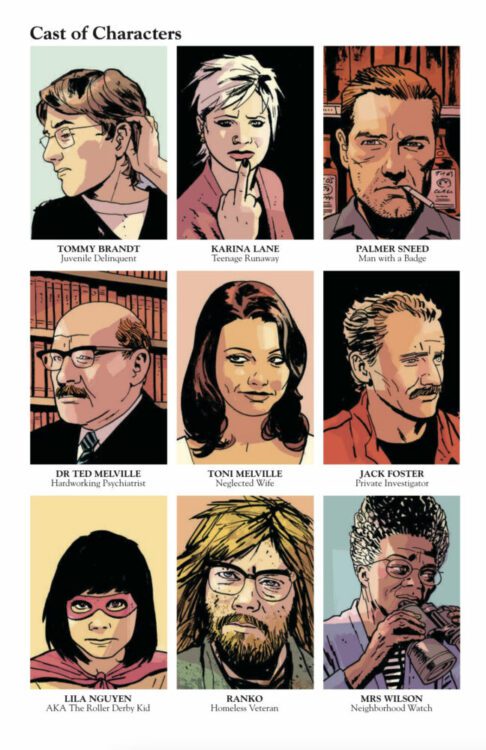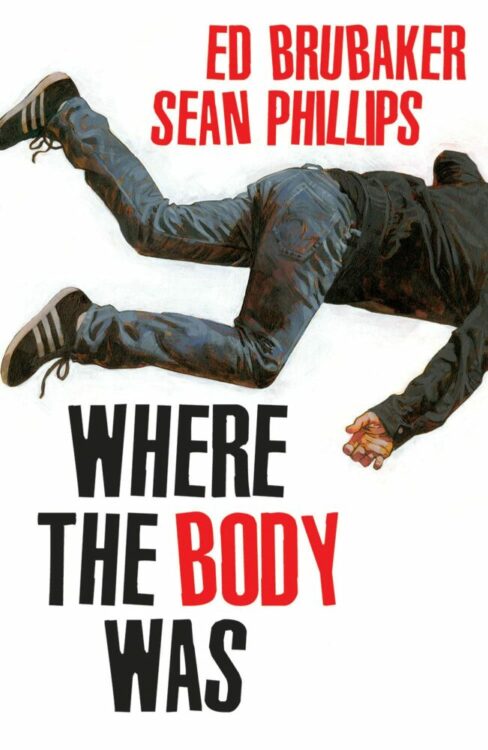With Where the Body Was, Ed Brubaker and Sean Phillips have done it again. I mean really, this is starting to get old. Could they please just come out with one project that isn’t amazing? No, they’re too consistent in their ability to deliver a near-perfect comic. Yet they’re also so versatile in their style and tone. Where the Body Was is totally unlike anything they’ve ever done. And what’s even more brilliant is that it pretends to be just like their past works, sneaking up on you with its quiet discussion of memories and old wounds.
Writing
Brubaker frames this comic as a murder mystery and makes you think that’s all there is to it. We follow the residents of Pelican Road in the Summer of ’84. Based on the title — Where the Body Was — we know there’s going to be a dead body that shows up at some point, and that there’s going to be some question of how it got there. Brubaker knows that we’re going into his book with this preconception. The book then jumps around in time and between narrators with a looseness that almost makes it feel unplanned and disjointed. “How in the world is he going to pull this all together?” you find yourself wondering. But then there’s the conclusion. Like the rest of the story, it’s not flashy or mind-blowing. In fact, it’s beautifully simple.
That’s because this book doesn’t rely solely on the intrigue factor. It really isn’t a murder mystery, when it comes down to it. It’s not about the interlocking secrets all the characters are keeping from each other. It’s about the human hearts that beat in the chests of these complicated individuals. Brubaker lets the tropes of crime comics and whodunnits fall to the wayside in favor of diving into the intimate details of each character’s soul. By the time you’re finished reading, you’ll feel like you’ve met a new set of friends. Even with their sinister sides and their glaring imperfections, Brubaker writes his cast in a way that makes them hard not to love.

Art
There’s a wonderful chaos to Sean Phillips’ art. You feel so much movement is happening on the page. Primarily, this happens because Phillips flips the placement of his characters panel by panel. In one panel, Tommy is standing to the right of Karina’s father, listening to his questions. A couple of panels later it’s Karina’s father who’s on the right and Tommy who’s on the left. At first this would seem like this has to do with who speaks first in each panel — you generally want that person to be on the left. But this even happens in panels where no one is speaking or only a single character talks. Elsewhere, we see multiple point-of-view shots in a single page. The most effective use of this is when we see the titular dead body from one character’s perspective, but then the next panel seems to be from the angle of the body looking up through lifeless eyes at the shocked face of the person who found it. Because this is a book with many narrators piecing together what happened, it makes sense that Phillips’ pages look like a collage of different viewpoints. We’re constantly shifting perspective both in the writing and in the art.
Jacob Phillips’ coloring is — as always — outstanding. There’s just so much mood to everything he does. At one point, a character recounts old memories that make him feel various emotions. When he talks about his father’s unceremonious death, the panel glows with red anger. When he discusses his upbringing and old memories that feel distant and stale, the page yellows as if from years of wear and tear. When he talks about a fantasy he used to have where he felt cool and on top of the world, the panel is a soft blue. The whole comic is drenched with feeling. But it’s also just beautiful. The speckled look of Phillips’ pages, the textured unevenness of his brushstrokes and the vibrancy of his juxtapositions make every page feel rich and inviting.

Lettering
There’s a ton of variety to Sean Phillips’ letters, but none of them feel flashy or distracting. It’s the kind of thing where you don’t even realize the information he’s communicating with his subtle differentiations, yet you’re taking it all in on a subliminal level. It’s really simple things like the change of a font, or even the change of casing, that lets you know that we’re seeing things from another perspective now. Then there are the things he does to add a little touch of life to each panel. When a character hides behind a menu because she’s afraid of being seen, it doesn’t just cover her face but overlaps her word balloon a little too. When another character sits in traffic, the “HNNK HNNK” noise of a car behind him frames the whole scene. The sound is everywhere. Phillips works so particularly in his lettering to add to what you’re reading without you even realizing it’s happening.
Conclusion
Where the Body Was is a book that exists in its own class and genre. It rises above the simple tropes of murder mysteries to bring us more than just intrigue. You’ll laugh, cry, and love with these deeply human characters. Brubaker, Phillips, and Phillips have outdone themselves yet again. Their work has never been so paradoxically raw and thought out. All at once it feels like something that has been years in the making and like something created in a moment of uninhibited passionate creativity. It’s truly something to behold. Where the Body Was will be released by Image Comics on December 5th. Don’t miss it!


